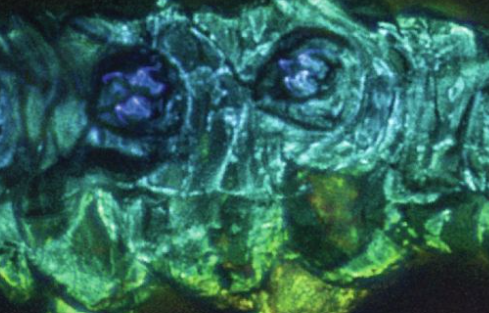Tardigrades, those tiny, resilient creatures with eight legs, have long fascinated scientists due to their incredible ability to survive in extreme environments. These microscopic organisms, often hailed as some of the toughest on the planet, have been around for an astonishingly long time. Molecular evidence suggests that tardigrades first appeared before the Cambrian period, over 541 million years ago, and have managed to endure through the ages, finding ways to thrive in nearly every corner of the Earth—from frozen tundras to arid deserts, and even at the bottom of the ocean.
Despite their widespread presence, the fossil record of tardigrades is remarkably sparse. Their minute size and soft bodies mean they decompose quickly, making fossilization a rare event. However, a few ancient tardigrades have been preserved in amber, a fortuitous outcome of these creatures becoming trapped in sticky tree resin millions of years ago, which eventually hardened. To date, only four tardigrade specimens have been discovered in amber, with these rare finds dating back nearly 150 million years. These specimens provide invaluable insights into tardigrade evolution and their extraordinary survival skills.
Tardigrades Trapped in Amber Reveal Secrets From Millions of Years Ago https://t.co/aEeOeqAWOz
— Evan Kirstel #B2B #TechFluencer (@EvanKirstel) August 24, 2024
Recently, a team of zoologists led by Marc Mapalo from Harvard University made significant strides in studying these ancient specimens using a technique called confocal fluorescence microscopy. This advanced imaging method uses a pinhole to capture highly detailed images of microscopic subjects, far surpassing the capabilities of traditional widefield microscopy. This technique has allowed researchers to examine two tardigrade specimens embedded in Canadian amber from the Cretaceous period, which dates back 72 to 83 million years, a time when non-avian dinosaurs still roamed the Earth.
One of these tardigrades, named Beorn leggi, was first described in 1964. Thanks to the detailed imaging provided by confocal microscopy, researchers were able to observe features of B. leggi that had eluded previous studies, such as the specific shape of its claws and the absence of certain protrusions on its body. The second specimen, previously too small and poorly preserved to study in detail, has now been named Aerobius dactylus and placed on its rightful branch in the complex tardigrade family tree.
Both B. leggi and A. dactylus share some characteristics typical of the Hypsibioidea superfamily of tardigrades, such as the similar structure of their claws. Interestingly, the claws on A. dactylus’s rearmost pair of legs are significantly longer, resembling those of the Isohypsibius genus. This finding suggests that the evolutionary path of the fourth pair of legs in tardigrades might differ from that of the other three pairs, a trait observed in some modern species as well.
These discoveries have not only expanded our understanding of the evolutionary history of tardigrades but also provided clues about their incredible resilience. Both B. leggi and A. dactylus belong to the eutardigrade lineage, primarily associated with freshwater habitats, which is thought to have diverged from the ocean-dwelling heterotardigrades around 500 million years ago. This timeline is slightly later than previously believed.
Moreover, by comparing these fossils with living tardigrades, researchers have been able to approximate when tardigrades developed one of their most remarkable survival strategies: cryptobiosis. This ability allows them to almost completely dehydrate and enter a state of suspended animation, effectively pausing their biological processes for indefinite periods. The study suggests that cryptobiosis may have emerged as early as 420 million years ago and certainly no later than 180 million years ago, a period that spans several of Earth’s mass extinctions. This ability likely played a crucial role in the tardigrades’ remarkable endurance and survival through catastrophic events that wiped out many other species.
How ‘water bears’ evolved their superpower https://t.co/ClyItBOarX Tardigrades trapped in amber reveal origins of their ability to survive deadly radiation, glacial temperatures, even bullet impacts
— Roger Highfield (@RogerHighfield) August 11, 2024
Quotes on these fascinating creatures
- Thomas Boothby, Biologist: “Tardigrades can repair their DNA and reduce oxidative damage, making them nearly indestructible. They could hold the key to understanding how to protect humans in space and against extreme radiation.”
- Giuseppe Guido, Tardigrade Researcher: “Tardigrades are essentially the superheroes of the micro-world. Their ability to withstand extreme conditions challenges our understanding of what life requires and how life can be maintained in the most uninhabitable environments.”
- Richard Dawkins, Evolutionary Biologist: “The survival skills of tardigrades make them the ultimate example of the persistence of life. They thrive where other organisms would perish, showing the incredible adaptability and resilience of life on Earth.”
Key Points:
i. Tardigrades have existed for over 541 million years, surviving in extreme environments worldwide, but their fossil record is limited due to their size and delicate bodies.
ii. Only four tardigrade specimens have been found preserved in amber, with two recently studied using confocal fluorescence microscopy to reveal new details.
iii. The two studied specimens, Beorn leggi and Aerobius dactylus, belong to the eutardigrade lineage and share characteristics with the Hypsibioidea superfamily, providing insights into their evolutionary history.
iv. The discovery of longer claws on A. dactylus’s rearmost legs suggests that tardigrade leg evolution may be more complex than previously understood.
v. Researchers have determined that tardigrades likely developed cryptobiosis, their ability to enter a state of suspended animation, between 420 and 180 million years ago, contributing to their survival through multiple mass extinctions.
TL Holcomb – Reprinted with permission of Whatfinger News



